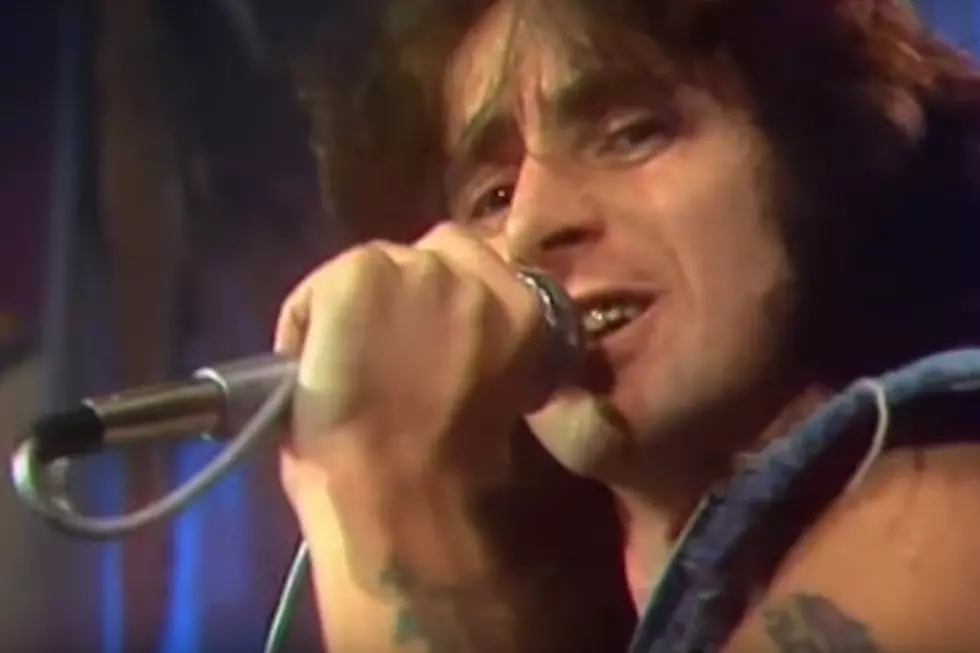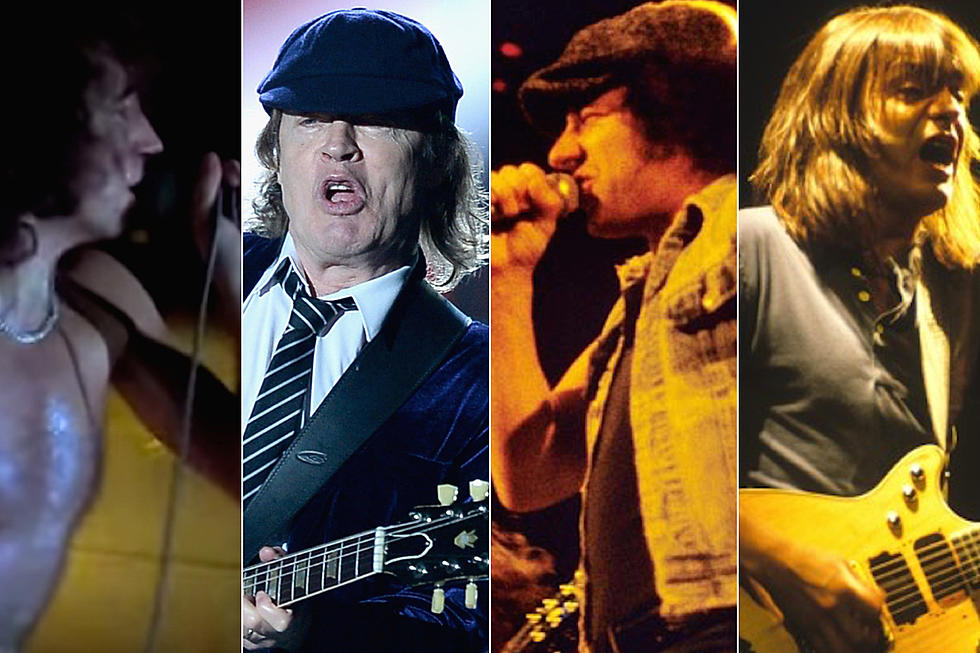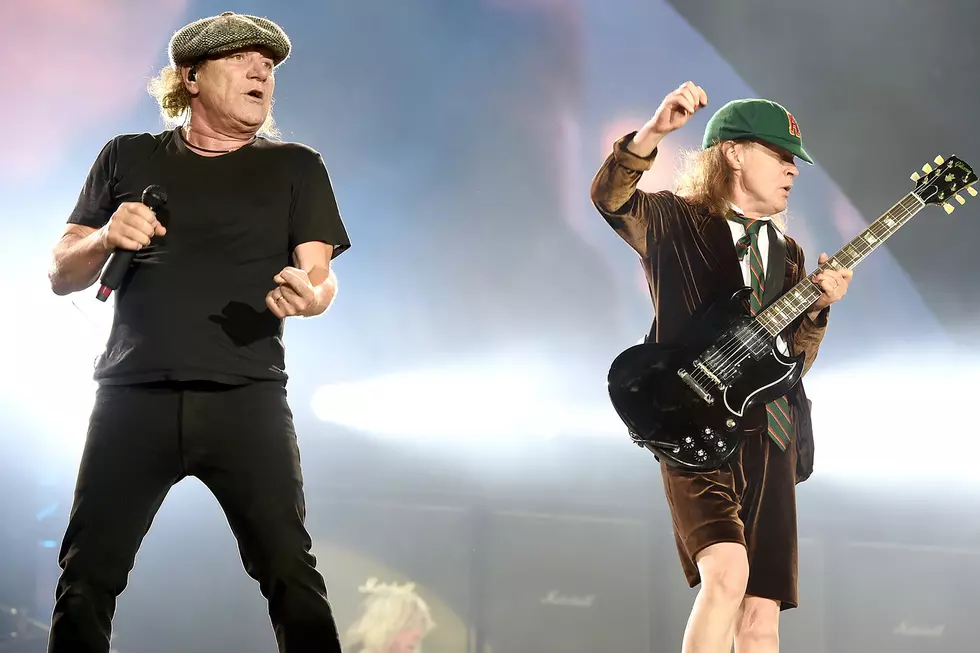
How AC/DC Recorded ‘Highway To Hell’ – Exclusive Book Excerpt
On Aug. 5, author Jesse Fink will release his third book, 'The Youngs: The Brothers Who Built AC/DC' via St. Martin's Press. The publication, available for purchase at Amazon, is considered to be less of a biography than a critical appreciation of the band's enduring appeal, with a focus on the titular brothers who have been their guiding force.
Across its 320 pages, the book spotlights 11 songs by the Youngs between 1968 and 1990 and reveals the stories behind them. Along the way, Fink spoke to former members of AC/DC to get their take, as well as perspective from musicians from Guns N' Roses, Dropkick Murphys and Rose Tattoo. Fink was generous enough to give us this lengthy, but fascinating, excerpt, which chronicles the making of one of AC/DC's most famous songs, 'Highway to Hell':
What is it about this song that makes it so much more powerful than anything else AC/DC had written or produced up to that stage of their career?
Is it the unforgettable chorus? Is it the opening power chord that builds to become a mountain of sound? Is it the production? Is it the good-time lyrics? Or is it the backing, almost baying, vocals that simply erupt when they arrive in the mix?
“That’s one of the things that first caught me when I heard it,” says Mark Evans. “Most of it is Bon. You can hear Malcolm coming through a bit. But you mostly hear Bon, which I found really odd, because it was like, ‘What’s that?’ But hey, listen. The proof’s in the pudding. To me personally it’s their best album.”
In his book 'Highway to Hell,' Joe Bonomo has a shot at divining its secret: “An effortless, head-rocking, arms-elevated, smile-lifting chorus so appealing and fun and full of filthy guarantees, and so layered with harmonized, gang-bellowed vocals that you feel surrounded at a smoky party.”
John Wheeler of Hayseed Dixie has his own theory: “It’s the perfect rock lyric. There are eight lines [in each verse] and a chorus, which is just the same line over and over, not counting ‘Don’t stop me!’ That’s pure genius: to write something so economical that absolutely says it. A lot of bands have a ‘sound,’ but when you strip the sound away and just play the song solo on an acoustic guitar there isn’t much actually there. That’s not the case with ‘Highway to Hell.’ That song works whether it’s played by a rock band, a bluegrass band or a brass marching band.”
But Tony Platt, its mixing engineer, puts it down to something more primal.
“It’s very spiky and angular,” he says. “But that gives you the punch. Just a damn good rhythm. Very simple and very straightforward. It’s just that stripped-down openness of the rhythm.”
Whatever it is that makes 'Highway to Hell' undoubtedly one of the top half-dozen in the Youngs’ songbook, it’s the single that not only broke AC/DC in the United States as a radio-friendly band but forced AC/DC’s haters -- and there were still many of them in 1979 -- to stop dead in their tracks.
“When the clip for ‘Highway to Hell’ popped up on TV I had to sit up and pay attention,” says Radio Birdman’s Chris Masuak. “The production was tough but polished enough for my ‘superior’ sensibilities and the guitar sounds were awesome. I went out and bought the record and had my first twinge of regret and guilt for being given a valuable guitar lesson almost too late. AC/DC didn’t rate in our camp but I’m glad that I finally got them.”
Tony Platt worked on four AC/DC records: 'Highway to Hell,' 'Back in Black,' 'Flick of the Switch' (as co-producer with Malcolm and Angus Young) and the soundtrack album to the film 'AC/DC: Let There Be Rock,' which is contained in the Bonfire box set.
The Englishman had been introduced to Lange through a mutual friend called Adam Sieff, who went on to become Sony’s director of jazz for the United Kingdom and Europe, and found someone who appreciated his pedigree: Lange wanted an engineer who was completely across the “fat” British rock sound and Platt, fortuitously, had worked with its foremost exponent: Free.
Their storied guitarist, Paul Kossoff, had not only left AC/DC in the lurch when he died on them before they were due to support his band Back Street Crawler in 1976 but left an indelible imprint on Malcolm Young’s tone. Free’s 'All Right Now' had been covered live by AC/DC in 1974 and, as Phil Sutcliffe points out in his biography, “the opening guitar figure of ‘You Ain’t Got a Hold on Me’ echoes Free’s ‘Wishing Well,’ with a lead solo by Malcolm” on the original Australian version of 'High Voltage.'
“When I heard what Lange was doing on 'Highway to Hell' I thought, ‘Oh, this is a step up,’” says Platt. “Some of the rawness had been refined a little bit where it needed to be but it hadn’t been overrefined or lost the energy. ‘Highway to Hell’ is probably the one song that owes most to ‘All Right Now’ in its construction. There are all sorts of things that come to bear [on a recording]. The desk that it was mixed on was the same desk that ‘All Right Now’ was mixed on. So there’s a certain tone that comes from that. The recording process is kind of a compromise at every step of the way because microphones are not quite as sensitive as ears in a lot of respects. And your brain processes sound in a particular way. And when you squeeze sound down wires all sorts of things happen to it.
“So really the job of an engineer and a producer is to try to reduce the amount of compromise that’s being applied. Now you can either do that by kind of chasing your tail with it or you can say, ‘Well, let’s turn this into a creative process.’ So then by choosing microphones, consoles, pieces of equipment and all those sort of things that address the compromises that you’re faced with [you can] actually turn them to your advantage in one way or another.”
Terry Manning, who’s also engineered for Lange, agrees choice of gear and equipment and even the room where the music is recorded has a massive effect on the resulting sound of an album.
“There is an influence,” he says. “It is true that whatever equipment you use and the way you utilize it will have an effect. But by far the biggest influence is the musicians and the sound that they are able to generate from the very beginning. And then second to that is the philosophy of the people recording it, in this case Tony and Mutt. A very big factor, too, I think, is the room itself because that’s one thing that was always so great about Compass Point: both studios, but especially Studio A, just had a really, really good room sound. You can also hear it on ‘Addicted to Love’ by Robert Palmer. The way things just sort of pop out.”
Continues Platt: “When you have a band like AC/DC who’ve got a very distinct sound, what you’re actually trying to do is not screw that up. You’re actually trying to get that across as faithfully as possible and, at the same time, if you can possibly do it, enhance it in ways that will make it sound larger than life so when it comes across on a record you come back to this thing of having the visual enhancement of imagining the band playing right in front of you.”
This is 'Highway to Hell’s' great triumph. Lange achieved something Vanda & Young could not. He makes you see the music: the Youngs’ small fingers digging into the strings, even the grooves on the strings. The sound is that delineated.
“What Mutt wanted to do was to capture some of that British rock essence, the fatness, rather than have the edginess that you got from American rock,” says Platt. “So, having worked on those sort of things, I knew it was a matter of not having loads of layers of guitars and things like that.
“It was about creating a sound where you felt you could actually picture the room with the band playing in it. There’s a certain amount of visual aspect that you need to conjure up with the sound. And it was a little tough to do with 'Highway to Hell' because it hadn’t been recorded in a way that enabled that to happen easily. So when I was asked to go back and do 'Back in Black' I’d already got in my head, ‘Well, I want to do this slightly differently.’
“So there’s even a movement from 'Highway to Hell' to 'Back in Black' in terms of opening that space and making it much more accessible. It’s the sort of sound where you can envisage [the band] in the room but at the same time you can dive into it and rub it all over yourself. You’ve got to be able to see the strings humming to feel it.”
It’s a testament to what a good job Lange and his team did on 'Highway to Hell' that other producers use it to test their studios.
“When we were recording ZZ Top’s 'Eliminator,'” says Manning, “Billy Gibbons and I would start every morning by listening to a cut or two from 'Highway to Hell' over the studio monitors, cranked up loud. This always got us revved up, in the mood for our rock ’n’ roll.
“Mutt wants something to be as professional and as able to translate to more of the world as possible, and maybe being ‘polished’ is a part of that, but he has always pushed the boundaries of technology, especially in that era, probably getting to certain ways of making things sound bigger, better, tighter and more compact than most people were doing at the time.”
For example, on 'Back in Black' Platt and Lange used Angus Young’s live radio set-up to send his guitar to different amplifiers in different rooms, creating a sound so unique that when they wanted to change a part of one of the solos during mixing and the radios weren’t available, matching the sound was very difficult. For the mix of 'Highway to Hell,' Platt also fed the guitar into the studio room in order to give it a “roomy” feel.
“Mutt was a terrific influence on AC/DC and a complete perfectionist,” says Phil Carson. “He got the very best out of AC/DC’s studio performances.”
In 1981, before working on 'For Those About to Rock,' the album that marked the end of his association with AC/DC, Lange (again with Platt in tow) produced Foreigner’s '4,' containing the superlative radio smashes 'Waiting for a Girl Like You' and 'Urgent,' which went to No. 2 and No. 4 respectively in the United States: his biggest hits to that date. Jimmy Douglass, AC/DC’s engineer on Live from the Atlantic Studios and considered for the Highway to Hell producer’s seat before Lange stepped in, worked on Foreigner’s first album.
“I was totally blown the f--- away by 'Highway to Hell,'” he says. “I wouldn’t have made the record like that. I didn’t see that [coming]. It was really retro Zeppelin to me, as I saw it. They f---ing nailed it. When I heard it, I was like, ‘Wow, that’s amazing.’ They were so powerful and so dynamic I didn’t see that as the direction they were going to take. The genius of Lange was that he went back and made something that we’d heard already and just made it f---ing better.”
Mario “The Big M” Medious, Atlantic’s legendary promotion executive who worked with Led Zeppelin in the early ’70s and was once described by Rolling Stone as the “hottest promo man in the music biz,” seconds Douglass: “AC/DC picked up where Zeppelin left off. They had the energy and mindblowing, must-play-loud sound that made them some bad mamajamas. I loved AC/DC.”
Lange, a fine musician in his own right, didn’t impose his imprint on the band but extracted the best he could from them without having them mutiny.
“He was someone who loved hooks, and loved chord constructions,” Ralph Simon told Larry LeBlanc. “He always used to stress that you have the principal hook and then you have four hooks in counterpoint flecking the major hook.” He was also “very much into the Eagles and the Eagles kind of sound” and was “so talented” that “he is probably the closest shoe-filler to Quincy Jones.”
A rare insight into Lange’s approach in the studio was given in a Billboard interview in 1998 by Trevor Horn, the great British producer of Frankie Goes to Hollywood, Grace Jones and Seal. Horn’s exacting, lush production places him comfortably in the same perfectionist category.
“Mutt Lange once said to me, ‘You get a band, you get them in a rehearsal room to do the songs, you rehearse them, you get them in a studio, you set them up, you go into the control room to listen, and it sounds like rubbish. That’s invariably what happens. After that, it’s a question of how much tenacity you have and how far you want to go.’ I think he’s right.”
The Youngs, as much as they grumbled about Lange’s painstaking ways, would have known they were in the presence of someone truly gifted. Michael Bolton, one of Lange’s most commercially successful acts, calls him “a mystic among producers -- a serene, sage-like Obi-Wan Kenobi.”
“He never really stamped his sound on those guys, like he did with Def Leppard and Shania Twain,” says Mike Fraser. “He’s definitely got a sound to him. 'Highway to Hell' and 'Back in Black' still sound like AC/DC to me. Mutt’s really good at defining everything. He helps bring that out either in the arrangement or the sound structure of the songs. But it was always there with AC/DC; it’s just a matter of how you’re presenting it. Mutt’s such a Type-A guy, so attentive to detail, so he makes sure that comes out. Mixing his stuff for 'Iron Man 2,' I have to say, boy, was it ever recorded well. You can almost just push the faders up and it was there.”
Says David Thoener, who mixed 'For Those About to Rock:' “I’d agree with Mike. Mutt always knows what he wants and hears it in his head, so it’s just a matter of time to get the artist to perform exactly as Mutt hears it in his head. Sometimes that’s bar by bar if necessary. He has more patience than anyone I’ve ever worked with and doesn’t settle.”
Thoener, a New Yorker, remembers spending a lot of time with Lange “on a mobile truck parked outside the Rolling Stones’ rehearsal room” at Quai de Bercy, Paris, recording what would be Lange’s swansong album with AC/DC. He’d been working with the J. Geils Band on 'Freeze Frame' when he got the call in June 1981 to come to France to work on the 'For Those About to Rock' sessions. Another J. Geils Band album, 1980’s 'Love Stinks,' was a Lange favorite.
“I thought I’d be done with J. Geils long before my August departure date. I was working 14 hours a day seven days a week and finished the last mix of 'Freeze Frame' on a Saturday, slept on Sunday and got on a plane to Paris on Monday.
“It was a big stone room, as I recall; quite a challenge. We worked from 10 am to midnight six days a week in Paris finishing the recording, then flew to London. I had off the day we flew to London and started mixing the next day six days a week 14 hours a day for a little over a month. By the time we were done, I was toast.
“We spent five days mixing the song ‘For Those About to Rock’ even though I felt we had it after the first day. It was only 24-track analog but Mutt didn’t give up until all his ideas had been addressed. Yes, he is a perfectionist. I believe that’s why all the artists he’s worked with have amazing-sounding records. Every song he’s involved with is a work of art. When you work with Mutt, as an engineer you just try to keep up and do your job to the best of your ability. He is always several steps ahead.”
That obsessive zeal to get it right, no matter how long it takes, required forbearance not only from AC/DC, who were used to getting in and getting out in the shortest possible time frame, and Lange’s overworked assistants but also from the project’s paymasters: Atlantic. They were happy to stand back and let the eccentric producer do his thing.
“I was told that he really didn’t like anybody in the studio,” says Jerry Greenberg. “So we honored his wishes. I was used to being in the studio, sitting there watching Jerry Wexler and Tom Dowd record Aretha Franklin. I’d walk in and I would see the genius of Wexler and Dowd. Mutt Lange, all I could do was hear the genius. But 'Highway to Hell' was a much sharper, much more well-produced record obviously than what we were getting with Vanda & Young.”
And what AC/DC’s American record company got for that patience, investment and tough decision making was everything they had been waiting for all along: a hit.
More From Ultimate Classic Rock









